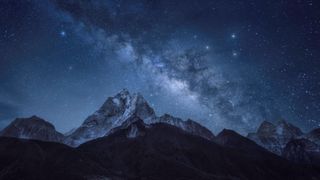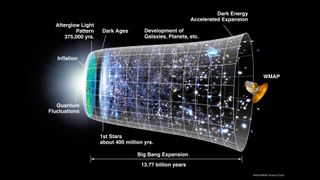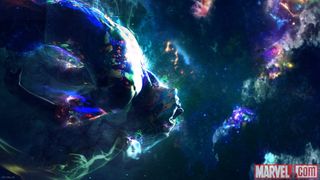Do parallel universes exist? We might live in a multiverse.
Sci-fi loves parallel universes. But could we really be in one?

Parallel universes are no longer just a feature of a good sci-fi story. There are now some scientific theories that support the idea of parallel universes beyond our own. However, the multiverse theory remains one of the most controversial theories in science.
Our universe is unimaginably big. Hundreds of billions, if not trillions, of galaxies spin through space, each containing billions or trillions of stars. Some researchers studying models of the universe speculate that the universe's diameter could be 7 billion light-years across. Others think it could be infinite.
But is it all that's out there? Science fiction loves the idea of a parallel universe, and the thought that we might be living just one of an infinite number of possible lives. Multiverses aren't reserved for "Star Trek," "Spiderman" and "Doctor Who," though. Real scientific theory explores, and in some cases supports, the case for universes outside, parallel to, or distant from but mirroring our own.
Multiverses and parallel worlds are often argued in the context of other major scientific concepts like the Big Bang, string theory and quantum mechanics.
Related: How big is the universe?
Eternal inflation, the Big Bang theory and parallel universes
Around 13.7 billion years ago, everything we know of was an infinitesimal singularity. Then, according to the Big Bang theory, it burst into action, inflating faster than the speed of light in all directions for a tiny fraction of a second. Before 10^-32 seconds had passed, the universe had exploded outward to 10^26 times its original size in a process called cosmic inflation. And that's all before the actual expansion of matter that we usually think of as the Big Bang itself, which was a consequence of all this inflation: As the inflation slowed, a flood of matter and radiation appeared, creating the classic Big Bang fireball, and began to form the atoms, molecules, stars and galaxies that populate the vastness of space that surrounds us.
Related: How an inflating universe could create a multiverse
That mysterious process of inflation and the Big Bang have convinced some researchers that multiple universes are possible, or even very likely. According to theoretical physicist Alexander Vilenkin of Tufts University in Massachusetts, inflation didn't end everywhere at the same time. While it ended for everything that we can detect from Earth 13.8 billion years ago, cosmic inflation in fact continues in other places. This is called the theory of eternal inflation. And as inflation ends in a particular place, a new bubble universe forms, Vilenkin wrote for Scientific American in 2011.
Those bubble universes can't contact each other because they continue to expand indefinitely. If we were to set off for the edge of our bubble, where it might butt up against the next bubble universe over, we'd never reach it because the edge is zipping away from us faster than the speed of light, and faster than we could ever travel.
Related: How many stars are in the universe?
But even if we could reach the next bubble, according to eternal inflation (combined with string theory), our familiar universe with its physical constants and habitable conditions could be totally different from the hypothetical bubble universe next to our own.
"This picture of the universe, or multiverse, as it is called, explains the long-standing mystery of why the constants of nature appear to be fine-tuned for the emergence of life," Vilenkin wrote. "The reason is that intelligent observers exist only in those rare bubbles in which, by pure chance, the constants happen to be just right for life to evolve. The rest of the multiverse remains barren, but no one is there to complain about that."
Vilenkin's explanation implies that in some of the infinite bubble universes outside our own, there could be other intelligent observers. But in every instant that passes, we get farther away from them, and we will never intersect.
Quantum mechanics and parallel universes
Some researchers base their ideas of parallel universes on quantum mechanics, the mathematical description of subatomic particles. In quantum mechanics, multiple states of existence for tiny particles are all possible at the same time — a "wave function" encapsulates all of those possibilities. However, when we actually look, we only ever observe one of the possibilities. According to the Copenhagen interpretation of quantum mechanics as described by the Stanford Encyclopedia of Philosophy, we observe an outcome when the wave function "collapses" into a single reality.
But the many-worlds theory proposes instead that every time one state, or outcome, is observed, there is another "world" in which a different quantum outcome becomes reality. This is a branching arrangement, in which instant by instant, our perceived universe branches into near-infinite alternatives. Those alternate universes are completely separate and unable to intersect, so while there may be uncountable versions of you living a life that's slightly — or wildly — different from your life in this world, you'd never know it.
Related: Black holes, aliens, multiverse & Mars: Space TED talks you need to watch
The many-worlds theory is the most "courageous" take on the quandary of quantum mechanics, physicist Sean Carroll wrote in his book, "Something Deeply Hidden: Quantum Worlds and the Emergence of Spacetime" (Dutton, 2019). He also argued that it is the most straightforward theory, although not without wrinkles.
One of those wrinkles is that the many-worlds idea is not really falsifiable. This is an important component of scientific thought and is the way the scientific community develops ideas that can be explored with observation and experimentation. If there's no opportunity to find evidence against a theory, that's bad for science as a whole, science journalist John Horgan argued in a blog post for Scientific American.
Infinite space, infinite universes?

Some physicists believe in a flatter version of multiple universes. That is, if the universe that we live in goes on forever, there are only so many ways that the building blocks of matter can arrange themselves as they assemble across infinite space. Eventually, any finite number of particle types must repeat a particular arrangement. Hypothetically, in a big enough space, those particles must repeat arrangements as large as entire solar systems and galaxies.
So, your entire life might be repeated elsewhere in the universe, down to what you ate for breakfast yesterday. At least, that's the theory.
But if the universe began at a finite point, as nearly every physicist agrees that it did, an alternate version of you likely doesn't exist, according to astrophysicist Ethan Siegel's 2015 Medium article.
According to Siegel, "the number of possible outcomes from particles in any Universe interacting with one another tends towards infinity faster than the number of possible Universes increases due to inflation."
"So what does this mean for you?" Siegel wrote. "It means it's up to you to make this Universe count."
The mirror-image universe

In a relatively recent addition to the pantheon of multiverse theories, researchers from the Perimeter Institute for Theoretical Physics in Waterloo, Ontario, have proposed that the universe began at the Big Bang — and on the opposite side of the Big Bang timeline, stretching backwards in time, a universe once existed that was the exact mirror image of our own.
"Instead of saying there was a different universe before the bang, we're saying that the universe before the bang is actually, in some sense, an image of the universe after the bang," Neil Turok, a Perimeter Institute researcher, told Space.com sister site Live Science.
That means everything — protons, electrons, even actions like cracking an egg — would be reversed. Antiprotons and positively charged electrons would make up atoms, while eggs would un-crack and make their way back inside chickens. Eventually, that universe would shrink down, presumably to a singularity, before expanding out into our own universe.
Seen another way, both universes were created at the Big Bang and exploded simultaneously backward and forward in time.
Multiverse: Arguments for and against
Arguments for the multiverse theory
Cosmic inflation
Our universe grew exponentially in the first moments of its existence, but was this expansion uniform? If not, it suggests different regions of space grew at different rates — and may be isolated from one another.
Mathematical constants
How are the laws of the universe so exact? Some propose that this happened only by chance — we are the one universe out of many that happened to get the numbers right.
The observable universe
What is beyond the edge of the observable space around us? No one knows for sure, and until we do (which could be never), the thought that ou universe extends indefinitely is an interesting one.
Arguments against the multiverse theory
Falsifiability
There is no way for us to ever test theories of the multiverse. We will never see beyond the observable universe, so if there is no way to disprove the theories, should they even be given credence?
Occam's razor
Sometimes, the simplest ideas are the best. Some physicists argue that we don't need the multiverse theory at all. It doesn't solve any paradoxes, and only creates complications.
No evidence
Not only can we not disprove any multiverse theory, we can't prove them either. We currently have no evidence that multiverses exists, and everything we can see suggests there is just one universe — our own.
Parallel universes in fiction

Countless works of myth and fiction draw from ideas of parallel universes and the multiverse. Overlapping worlds make appearances in Norse mythology as well as Buddhist and Hindu cosmology. The idea of multiple universes coming into contact showed up in print as early as Edwin A. Abbott's novella "Flatland: A Romance of Many Dimensions" (Seeley & Co., 1884), and can still be seen in recent movies such as the 2016 Marvel film "Doctor Strange." An entire genre of Japanese graphic novels, called isekai, deals with characters transported to parallel worlds, as described by the New York Public Library.
Nearly every "Star Trek" series incorporates some form of mirror universe, and the 2009 reboot film starring Chris Pine and Zachary Quinto took subsequent "Star Trek" movies into an entirely new timeline that explicitly branches off from the original series.
And comics, as well as their corresponding movies, delve deeply into the idea of parallel worlds. Recent Marvel Comics' storylines (both film and in print), DC's Flashpoint arc and 2018's "Into the Spider-Verse" all explore multiple universes and the intersections between them.
This is an incomplete list of some appearances of multiverses, split-timeline universes and parallel universes in fiction:
Movies
- Into the Spider-Verse (2018)
- Terminator Genisys (2015)
- Phineas and Ferb the Movie: Across the Second Dimension (2011)
- Star Trek (2009)
- Donnie Darko (2001)
- Run Lola Run (1998)
- Sliding Doors (1998)
- Back to the Future 1-3 (1985, 1989, 1990)
- The Adventures of Buckaroo Banzai Across the 8th Dimension (1984)
Television
- Star Trek: Discovery, multiple episodes
- Star Trek: Enterprise, multiple episodes
- Star Trek: Deep Space Nine, multiple episodes
- Star Trek: The Next Generation, "Parallels" (Episode 11, Season 7) (1993)
- Star Trek: The Original Series, "Mirror, Mirror", (Episode 4, Season 2) (1967)
- Doctor Who, multiple episodes
- Sliders, entire series
- Community, "Remedial Chaos Theory" (Episode 4, Season 3) (2011)
- Rick and Morty, multiple episodes
- Futurama, multiple episodes
- Eureka, multiple episodes
- Agents of Shield, multiple episodes
- "The Chronicles of Narnia" series (Geoffrey Bles, 1950-56) by C. S. Lewis
- "His Dark Materials" series (Scholastic, 1995-2000) by Phillip Pullman
- The "Discworld" series (HarperCollins, 1983-2015) by Terry Pratchett
- "Men Like Gods" (Macmillan, 1923) by H. G. Wells
- "The Dark Tower" series (Donald M. Grant, 1982-2012) by Stephen King
Video games
- BioShock Infinite, 2013
- Kingdom Hearts, 2002-2020
- Chrono Cross, 1999
- Half-Life, 1998-2020
- Metroid Prime 2: Echoes, 2004
- Zero Escape, 2009-2016
This article was adapted in part from previous work by Space.com contributor Elizabeth Howell.
Join our Space Forums to keep talking space on the latest missions, night sky and more! And if you have a news tip, correction or comment, let us know at: community@space.com.
Get the Space.com Newsletter
Breaking space news, the latest updates on rocket launches, skywatching events and more!

Daisy Dobrijevic joined Space.com in February 2022 having previously worked for our sister publication All About Space magazine as a staff writer. Before joining us, Daisy completed an editorial internship with the BBC Sky at Night Magazine and worked at the National Space Centre in Leicester, U.K., where she enjoyed communicating space science to the public. In 2021, Daisy completed a PhD in plant physiology and also holds a Master's in Environmental Science, she is currently based in Nottingham, U.K. Daisy is passionate about all things space, with a penchant for solar activity and space weather. She has a strong interest in astrotourism and loves nothing more than a good northern lights chase!
